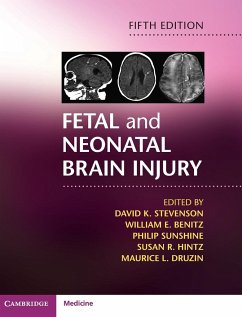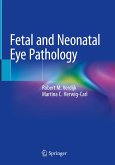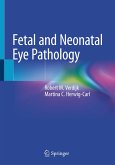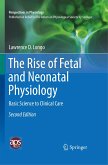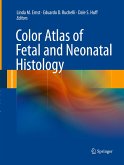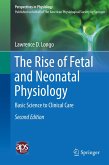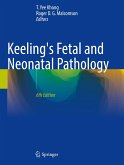Fetal and Neonatal Brain Injury
Herausgeber: Stevenson, David K.; Sunshine, Philip; Benitz, William E.
Fetal and Neonatal Brain Injury
Herausgeber: Stevenson, David K.; Sunshine, Philip; Benitz, William E.
- Gebundenes Buch
- Merkliste
- Auf die Merkliste
- Bewerten Bewerten
- Teilen
- Produkt teilen
- Produkterinnerung
- Produkterinnerung
Authoritative, practical clinical text giving clear management advice on diagnosis, treatment and outcomes of all fetal and neonatal brain injuries.
Andere Kunden interessierten sich auch für
![Fetal and Neonatal Eye Pathology Fetal and Neonatal Eye Pathology]() Robert M. VerdijkFetal and Neonatal Eye Pathology110,99 €
Robert M. VerdijkFetal and Neonatal Eye Pathology110,99 €![Fetal and Neonatal Eye Pathology Fetal and Neonatal Eye Pathology]() Robert M. VerdijkFetal and Neonatal Eye Pathology117,69 €
Robert M. VerdijkFetal and Neonatal Eye Pathology117,69 €![The Rise of Fetal and Neonatal Physiology The Rise of Fetal and Neonatal Physiology]() Lawrence D. LongoThe Rise of Fetal and Neonatal Physiology221,99 €
Lawrence D. LongoThe Rise of Fetal and Neonatal Physiology221,99 €![Color Atlas of Fetal and Neonatal Histology Color Atlas of Fetal and Neonatal Histology]() Color Atlas of Fetal and Neonatal Histology139,99 €
Color Atlas of Fetal and Neonatal Histology139,99 €![The Rise of Fetal and Neonatal Physiology The Rise of Fetal and Neonatal Physiology]() Lawrence D. LongoThe Rise of Fetal and Neonatal Physiology221,99 €
Lawrence D. LongoThe Rise of Fetal and Neonatal Physiology221,99 €![Keeling's Fetal and Neonatal Pathology Keeling's Fetal and Neonatal Pathology]() Keeling's Fetal and Neonatal Pathology81,99 €
Keeling's Fetal and Neonatal Pathology81,99 €![Physiology of the Fetal and Neonatal Lung Physiology of the Fetal and Neonatal Lung]() Physiology of the Fetal and Neonatal Lung42,99 €
Physiology of the Fetal and Neonatal Lung42,99 €-
-
-
Authoritative, practical clinical text giving clear management advice on diagnosis, treatment and outcomes of all fetal and neonatal brain injuries.
Hinweis: Dieser Artikel kann nur an eine deutsche Lieferadresse ausgeliefert werden.
Hinweis: Dieser Artikel kann nur an eine deutsche Lieferadresse ausgeliefert werden.
Produktdetails
- Produktdetails
- Verlag: Cambridge University Press
- Seitenzahl: 854
- Erscheinungstermin: 21. Dezember 2017
- Englisch
- Abmessung: 260mm x 208mm x 50mm
- Gewicht: 2017g
- ISBN-13: 9781107110809
- ISBN-10: 1107110807
- Artikelnr.: 49154736
- Herstellerkennzeichnung
- Books on Demand GmbH
- In de Tarpen 42
- 22848 Norderstedt
- info@bod.de
- 040 53433511
- Verlag: Cambridge University Press
- Seitenzahl: 854
- Erscheinungstermin: 21. Dezember 2017
- Englisch
- Abmessung: 260mm x 208mm x 50mm
- Gewicht: 2017g
- ISBN-13: 9781107110809
- ISBN-10: 1107110807
- Artikelnr.: 49154736
- Herstellerkennzeichnung
- Books on Demand GmbH
- In de Tarpen 42
- 22848 Norderstedt
- info@bod.de
- 040 53433511
Part I. Epidemiology, Pathophysiology, and Pathogenesis of Fetal and Neonatal Brain Injury: 1. Neonatal encephalopathy: epidemiology and overview
2. Neuronal cell death mechanisms relevant to humans: rethinking modeling neonatal hypoxic-ischemic encephalopathy
3. Cellular and molecular biology of hypoxic-ischemic encephalopathy
4. The pathogenesis of preterm brain injury
Part II. Pregnancy, Labor, and Delivery Complications Causing Brain Injury: 5. Prematurity and complications of labor and delivery
6. Risks and complications of multiple gestation
7. Intrauterine growth restriction
8. Maternal diseases that affect fetal and neonatal neurodevelopment
9. Obstetrical conditions and practices that affect the fetus and newborn
10. Fetal and neonatal injury as a consequence of maternal substance abuse
11. Hypertensive disorders of pregnancy
12. Complications of labour and delivery
13. Fetal responses to asphyxia
14. Antepartum evaluation of fetal well-being
15. Intrapartum evaluation of the fetus
Part III. Diagnosis of the Infant with Brain Injury: 16. Clinical manifestations of hypoxic-ischemic encephalopathy
17. The use of EEG and aEEG in assessing the term and preterm brain
18. Neuroimaging in the evaluation of pattern and timing of fetal and neonatal brain abnormalities
19. Light-based assessment of the brain
20. Placental pathology and the etiology of fetal and neonatal brain injury
21. Timing perinatal hypoxic-ischemic brain injury
Part IV. Specific Conditions Associated with Fetal and Neonatal Brain Injury: 22. Congenital malformations of the brain
23. Neurogenetic disorders of the brain
24. Hemorrhagic lesions of the central nervous system
25. Neonatal stroke
26. Neurodevelopmental consequences of neonatal hypoglycemia
27. Hyperbilirubinemia and kernicterus
28. Polycythemia and fetal-maternal bleeding
29. Hydrops fetalis
30. Bacterial sepsis in the neonate
31. Neonatal bacterial meningitis
32. Neurological sequelae of congenital and perinatal infections
33. Neurological complications of perinatal human immunodeficiency virus infection
34. Inborn errors of metabolism and single gene disorders with features of neonatal encephalopathy
35. Acidosis and alkalosis
36. Persistent pulmonary hypertension of the newborn
37. Pediatric cardiac surgery: relevance to fetal and neonatal brain injury
38. Neonatal resuscitation: immediate management
39. Improving performance, reducing error, and minimizing risk in the delivery room
40. Extended management following resuscitation
41. Endogenous and exogenous neuroprotective mechanisms after hypoxic-ischemic injury
42. Neonatal seizures: evaluation, treatment, and prognosis
43. Nutritional support of the asphyxiated infant
44. Early outcomes after extremely preterm birth
45. Cerebral palsy: advances in definition, classification, management and outcome
46. Neurodevelopmental and neurobehavioral outcomes of prematurity: cognition, language, academic skills, and behavioral and emotional profiles
47. Neurocognitive outcomes in term infants with neonatal encephalopathy
48. Neonatal neuroethics
49. Medicolegal issues in perinatal brain injury.
2. Neuronal cell death mechanisms relevant to humans: rethinking modeling neonatal hypoxic-ischemic encephalopathy
3. Cellular and molecular biology of hypoxic-ischemic encephalopathy
4. The pathogenesis of preterm brain injury
Part II. Pregnancy, Labor, and Delivery Complications Causing Brain Injury: 5. Prematurity and complications of labor and delivery
6. Risks and complications of multiple gestation
7. Intrauterine growth restriction
8. Maternal diseases that affect fetal and neonatal neurodevelopment
9. Obstetrical conditions and practices that affect the fetus and newborn
10. Fetal and neonatal injury as a consequence of maternal substance abuse
11. Hypertensive disorders of pregnancy
12. Complications of labour and delivery
13. Fetal responses to asphyxia
14. Antepartum evaluation of fetal well-being
15. Intrapartum evaluation of the fetus
Part III. Diagnosis of the Infant with Brain Injury: 16. Clinical manifestations of hypoxic-ischemic encephalopathy
17. The use of EEG and aEEG in assessing the term and preterm brain
18. Neuroimaging in the evaluation of pattern and timing of fetal and neonatal brain abnormalities
19. Light-based assessment of the brain
20. Placental pathology and the etiology of fetal and neonatal brain injury
21. Timing perinatal hypoxic-ischemic brain injury
Part IV. Specific Conditions Associated with Fetal and Neonatal Brain Injury: 22. Congenital malformations of the brain
23. Neurogenetic disorders of the brain
24. Hemorrhagic lesions of the central nervous system
25. Neonatal stroke
26. Neurodevelopmental consequences of neonatal hypoglycemia
27. Hyperbilirubinemia and kernicterus
28. Polycythemia and fetal-maternal bleeding
29. Hydrops fetalis
30. Bacterial sepsis in the neonate
31. Neonatal bacterial meningitis
32. Neurological sequelae of congenital and perinatal infections
33. Neurological complications of perinatal human immunodeficiency virus infection
34. Inborn errors of metabolism and single gene disorders with features of neonatal encephalopathy
35. Acidosis and alkalosis
36. Persistent pulmonary hypertension of the newborn
37. Pediatric cardiac surgery: relevance to fetal and neonatal brain injury
38. Neonatal resuscitation: immediate management
39. Improving performance, reducing error, and minimizing risk in the delivery room
40. Extended management following resuscitation
41. Endogenous and exogenous neuroprotective mechanisms after hypoxic-ischemic injury
42. Neonatal seizures: evaluation, treatment, and prognosis
43. Nutritional support of the asphyxiated infant
44. Early outcomes after extremely preterm birth
45. Cerebral palsy: advances in definition, classification, management and outcome
46. Neurodevelopmental and neurobehavioral outcomes of prematurity: cognition, language, academic skills, and behavioral and emotional profiles
47. Neurocognitive outcomes in term infants with neonatal encephalopathy
48. Neonatal neuroethics
49. Medicolegal issues in perinatal brain injury.
Part I. Epidemiology, Pathophysiology, and Pathogenesis of Fetal and Neonatal Brain Injury: 1. Neonatal encephalopathy: epidemiology and overview
2. Neuronal cell death mechanisms relevant to humans: rethinking modeling neonatal hypoxic-ischemic encephalopathy
3. Cellular and molecular biology of hypoxic-ischemic encephalopathy
4. The pathogenesis of preterm brain injury
Part II. Pregnancy, Labor, and Delivery Complications Causing Brain Injury: 5. Prematurity and complications of labor and delivery
6. Risks and complications of multiple gestation
7. Intrauterine growth restriction
8. Maternal diseases that affect fetal and neonatal neurodevelopment
9. Obstetrical conditions and practices that affect the fetus and newborn
10. Fetal and neonatal injury as a consequence of maternal substance abuse
11. Hypertensive disorders of pregnancy
12. Complications of labour and delivery
13. Fetal responses to asphyxia
14. Antepartum evaluation of fetal well-being
15. Intrapartum evaluation of the fetus
Part III. Diagnosis of the Infant with Brain Injury: 16. Clinical manifestations of hypoxic-ischemic encephalopathy
17. The use of EEG and aEEG in assessing the term and preterm brain
18. Neuroimaging in the evaluation of pattern and timing of fetal and neonatal brain abnormalities
19. Light-based assessment of the brain
20. Placental pathology and the etiology of fetal and neonatal brain injury
21. Timing perinatal hypoxic-ischemic brain injury
Part IV. Specific Conditions Associated with Fetal and Neonatal Brain Injury: 22. Congenital malformations of the brain
23. Neurogenetic disorders of the brain
24. Hemorrhagic lesions of the central nervous system
25. Neonatal stroke
26. Neurodevelopmental consequences of neonatal hypoglycemia
27. Hyperbilirubinemia and kernicterus
28. Polycythemia and fetal-maternal bleeding
29. Hydrops fetalis
30. Bacterial sepsis in the neonate
31. Neonatal bacterial meningitis
32. Neurological sequelae of congenital and perinatal infections
33. Neurological complications of perinatal human immunodeficiency virus infection
34. Inborn errors of metabolism and single gene disorders with features of neonatal encephalopathy
35. Acidosis and alkalosis
36. Persistent pulmonary hypertension of the newborn
37. Pediatric cardiac surgery: relevance to fetal and neonatal brain injury
38. Neonatal resuscitation: immediate management
39. Improving performance, reducing error, and minimizing risk in the delivery room
40. Extended management following resuscitation
41. Endogenous and exogenous neuroprotective mechanisms after hypoxic-ischemic injury
42. Neonatal seizures: evaluation, treatment, and prognosis
43. Nutritional support of the asphyxiated infant
44. Early outcomes after extremely preterm birth
45. Cerebral palsy: advances in definition, classification, management and outcome
46. Neurodevelopmental and neurobehavioral outcomes of prematurity: cognition, language, academic skills, and behavioral and emotional profiles
47. Neurocognitive outcomes in term infants with neonatal encephalopathy
48. Neonatal neuroethics
49. Medicolegal issues in perinatal brain injury.
2. Neuronal cell death mechanisms relevant to humans: rethinking modeling neonatal hypoxic-ischemic encephalopathy
3. Cellular and molecular biology of hypoxic-ischemic encephalopathy
4. The pathogenesis of preterm brain injury
Part II. Pregnancy, Labor, and Delivery Complications Causing Brain Injury: 5. Prematurity and complications of labor and delivery
6. Risks and complications of multiple gestation
7. Intrauterine growth restriction
8. Maternal diseases that affect fetal and neonatal neurodevelopment
9. Obstetrical conditions and practices that affect the fetus and newborn
10. Fetal and neonatal injury as a consequence of maternal substance abuse
11. Hypertensive disorders of pregnancy
12. Complications of labour and delivery
13. Fetal responses to asphyxia
14. Antepartum evaluation of fetal well-being
15. Intrapartum evaluation of the fetus
Part III. Diagnosis of the Infant with Brain Injury: 16. Clinical manifestations of hypoxic-ischemic encephalopathy
17. The use of EEG and aEEG in assessing the term and preterm brain
18. Neuroimaging in the evaluation of pattern and timing of fetal and neonatal brain abnormalities
19. Light-based assessment of the brain
20. Placental pathology and the etiology of fetal and neonatal brain injury
21. Timing perinatal hypoxic-ischemic brain injury
Part IV. Specific Conditions Associated with Fetal and Neonatal Brain Injury: 22. Congenital malformations of the brain
23. Neurogenetic disorders of the brain
24. Hemorrhagic lesions of the central nervous system
25. Neonatal stroke
26. Neurodevelopmental consequences of neonatal hypoglycemia
27. Hyperbilirubinemia and kernicterus
28. Polycythemia and fetal-maternal bleeding
29. Hydrops fetalis
30. Bacterial sepsis in the neonate
31. Neonatal bacterial meningitis
32. Neurological sequelae of congenital and perinatal infections
33. Neurological complications of perinatal human immunodeficiency virus infection
34. Inborn errors of metabolism and single gene disorders with features of neonatal encephalopathy
35. Acidosis and alkalosis
36. Persistent pulmonary hypertension of the newborn
37. Pediatric cardiac surgery: relevance to fetal and neonatal brain injury
38. Neonatal resuscitation: immediate management
39. Improving performance, reducing error, and minimizing risk in the delivery room
40. Extended management following resuscitation
41. Endogenous and exogenous neuroprotective mechanisms after hypoxic-ischemic injury
42. Neonatal seizures: evaluation, treatment, and prognosis
43. Nutritional support of the asphyxiated infant
44. Early outcomes after extremely preterm birth
45. Cerebral palsy: advances in definition, classification, management and outcome
46. Neurodevelopmental and neurobehavioral outcomes of prematurity: cognition, language, academic skills, and behavioral and emotional profiles
47. Neurocognitive outcomes in term infants with neonatal encephalopathy
48. Neonatal neuroethics
49. Medicolegal issues in perinatal brain injury.

